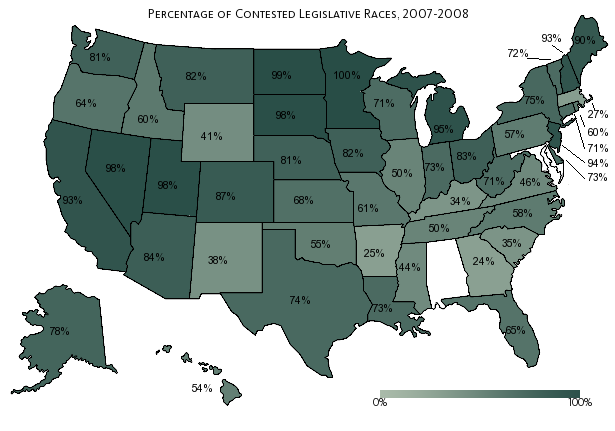Reports Find Lack of Competition in State Legislative Races
Only 22 percent of state legislative candidates had a monetarily competitive race in the 2007-2008 cycle, according to a study released today by the National
Jul 31, 202033.3K Shares565.1K Views
Only 22 percent of state legislative candidates had a monetarily competitive race in the 2007-2008 cycle, according to a study released today by the National Institute on Money in State Politics, meaning that 78 percent of the leading fundraisers in a campaign raised more than twice the amount of the next-highest fundraiser, if they even had one. A quarter of state legislative races in the last cycle had only one name listed on the ballot for either the primary or general election.
So where are the most competitive races? Well, they’re not in Georgia. If you live there, your state legislative races are the least competitive of any state, according to the study’s formula, which takes into account the presence of challengers and money raised. Minnesota is at the other end of the spectrum as the only state where every candidate had a general-election contest in the 2008 cycle.
Check out the competitiveness map after the jump:
By overall geographic region, the South is home to the least competitive legislative elections. States in the Midwest and Mountain West had the highest number of contested races.
In addition to geographic parallels, the study claims to have identified three additional patterns related to election competition. The first is public funding — five of the ten most competitive states offered public funding for campaigns. The second is the cost of campaigning — the cost is inversely related to competitiveness. And the third is business contributions — the study notes the three states with the smallest amount of business contributions were among the five most competitive.
A second study released today by the National Institute on Money and State Politicsfound that the advantage of incumbency remained strong at the legislative level last cycle, especially when combined with fundraising ability.
While these studies can be used to help make the case for public financing, as I read the data, I couldn’t help but think of Ruth Marcus’ editorial in the Post Wednesday on Arizona’s state legislature. Arizona has “one of the most far-reaching public financing laws in the nation,” Marcus writes, but it also yielded some unintended consequences in the state. Read Marcus’ entire piece for more on Arizona’s current situation.

Rhyley Carney
Reviewer
Latest Articles
Popular Articles
